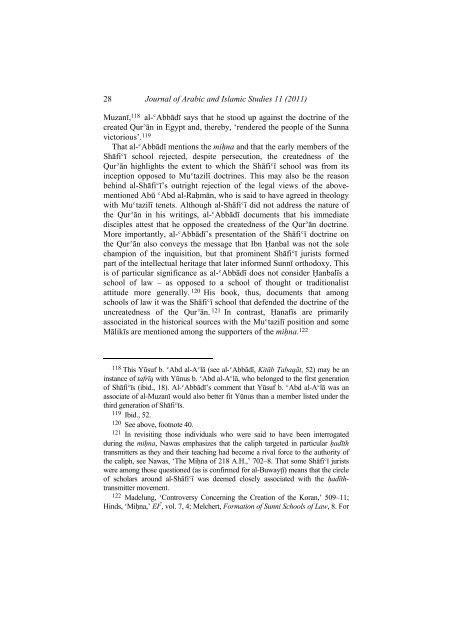JOURNAL OF ARABIC AND ISLAMIC STUDIES
JOURNAL OF ARABIC AND ISLAMIC STUDIES
JOURNAL OF ARABIC AND ISLAMIC STUDIES
Create successful ePaper yourself
Turn your PDF publications into a flip-book with our unique Google optimized e-Paper software.
28<br />
Journal of Arabic and Islamic Studies 11 (2011)<br />
Muzanī, 118 al-ʿAbbādī says that he stood up against the doctrine of the<br />
created Qurʾān in Egypt and, thereby, ‘rendered the people of the Sunna<br />
victorious’. 119<br />
That al-ʿAbbādī mentions the miḥna and that the early members of the<br />
Shāfiʿī school rejected, despite persecution, the createdness of the<br />
Qurʾān highlights the extent to which the Shāfiʿī school was from its<br />
inception opposed to Muʿtazilī doctrines. This may also be the reason<br />
behind al-Shāfiʿī’s outright rejection of the legal views of the abovementioned<br />
Abū ʿAbd al-Raḥmān, who is said to have agreed in theology<br />
with Muʿtazilī tenets. Although al-Shāfiʿī did not address the nature of<br />
the Qurʾān in his writings, al-ʿAbbādī documents that his immediate<br />
disciples attest that he opposed the createdness of the Qurʾān doctrine.<br />
More importantly, al-ʿAbbādī’s presentation of the Shāfiʿī doctrine on<br />
the Qurʾān also conveys the message that Ibn Ḥanbal was not the sole<br />
champion of the inquisition, but that prominent Shāfiʿī jurists formed<br />
part of the intellectual heritage that later informed Sunnī orthodoxy. This<br />
is of particular significance as al-ʿAbbādī does not consider Ḥanbalīs a<br />
school of law – as opposed to a school of thought or traditionalist<br />
attitude more generally. 120 His book, thus, documents that among<br />
schools of law it was the Shāfiʿī school that defended the doctrine of the<br />
uncreatedness of the Qurʾān. 121 In contrast, Ḥanafīs are primarily<br />
associated in the historical sources with the Muʿtazilī position and some<br />
Mālikīs are mentioned among the supporters of the miḥna. 122<br />
118 This Yūsuf b. ʿAbd al-Aʿlā (see al-ʿAbbādī, Kitāb Ṭabaqāt, 52) may be an<br />
instance of tafrīq with Yūnus b. ʿAbd al-Aʿlā, who belonged to the first generation<br />
of Shāfiʿīs (ibid., 18). Al-ʿAbbādī’s comment that Yūsuf b. ʿAbd al-Aʿlā was an<br />
associate of al-Muzanī would also better fit Yūnus than a member listed under the<br />
third generation of Shāfiʿīs.<br />
119 Ibid., 52.<br />
120 See above, footnote 40.<br />
121 In revisiting those individuals who were said to have been interrogated<br />
during the miḥna, Nawas emphasizes that the caliph targeted in particular ḥadīth<br />
transmitters as they and their teaching had become a rival force to the authority of<br />
the caliph, see Nawas, ‘The Miḥna of 218 A.H.,’ 702–8. That some Shāfiʿī jurists<br />
were among those questioned (as is confirmed for al-Buwayṭī) means that the circle<br />
of scholars around al-Shāfiʿī was deemed closely associated with the ḥadīthtransmitter<br />
movement.<br />
122 Madelung, ‘Controversy Concerning the Creation of the Koran,’ 509–11;<br />
Hinds, ‘Miḥna,’ EI 2 , vol. 7, 4; Melchert, Formation of Sunni Schools of Law, 8. For

















